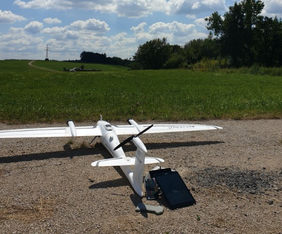Unmanned, autonomously flying drones are to be used in the future to monitor public infrastructure. Their use is intended, for example, to support Deutsche Bahn in monitoring the rail network for impairments caused by adjacent vegetation. Data is transmitted in real time from a drone camera to a control station. Today, LTE mobile communications networks offer good coverage for this purpose. The new 5G mobile communications generation will significantly improve transmission in the future. However, mobile networks have so far only been designed for use on the ground and have not been optimized for drone applications.
To test the novel applications, researchers at Ingolstadt University of Technology conducted field trials together with drone manufacturer Quantum-Systems and mobile phone manufacturer Ericsson. The trials took place in the "5G-Connected Mobility" test field near Nuremberg, where Ericsson has been operating an experimental mobile network for several years using new 5G techniques such as edge computing and network slicing. The test drone is based on an electric glider from Quantum-Systems, which is optimized for long-range flights. For the tests, the drone was equipped with hardware and software for test execution and flights were conducted at different altitudes, in areas with good and poor reception, and short and long flight distances with switching between base stations. This allowed various system configurations to be tested in the 5G test network. The tests showed that 5G meets the drone requirements for reliable data transmission in real time and has clear advantages compared to LTE.
Prof. Dr. Andreas Festag, professor of vehicle safety and Car2X communications at Ingolstadt University of Technology, emphasizes, "The trials have shown that 5G has great potential for transmitting payload data in drone applications." Pierre Ulfig, head of marketing, sales and service at Quantum-Systems, emphasizes, "Area-covering mobile communications with high data rates and reliability enable a wide range of infrastructure projects with drones with long flight distances, for example in road construction or agriculture." Ralf Wellens, project manager of 5G-ConnectedMobility at Ericsson adds, "5G networks are true high-flyers. Like our 5G-ConnectedMobility testbed itself, they were developed for users on the ground. One very interesting finding is that the technology provides good enough connectivity for drones flying at altitudes of up to 120 meters."
The field tests are part of the "FreeRail" project, funded by the German Federal Ministry of Transport and Digital Infrastructure (BMVI), which is developing a system for vegetation control of the rail network. Partners in the project include Ingolstadt University of Technology, Quantum-Systems GmbH, DB Fahrwegdienste GmbH, the city of Ingolstadt and geo-konzept GmbH.



![[Translate to English:] Logo Akkreditierungsrat: Systemakkreditiert](/fileadmin/_processed_/2/8/csm_AR-Siegel_Systemakkreditierung_bc4ea3377d.webp)








![[Translate to English:] Logo IHK Ausbildungsbetrieb 2023](/fileadmin/_processed_/6/0/csm_IHK_Ausbildungsbetrieb_digital_2023_6850f47537.webp)


